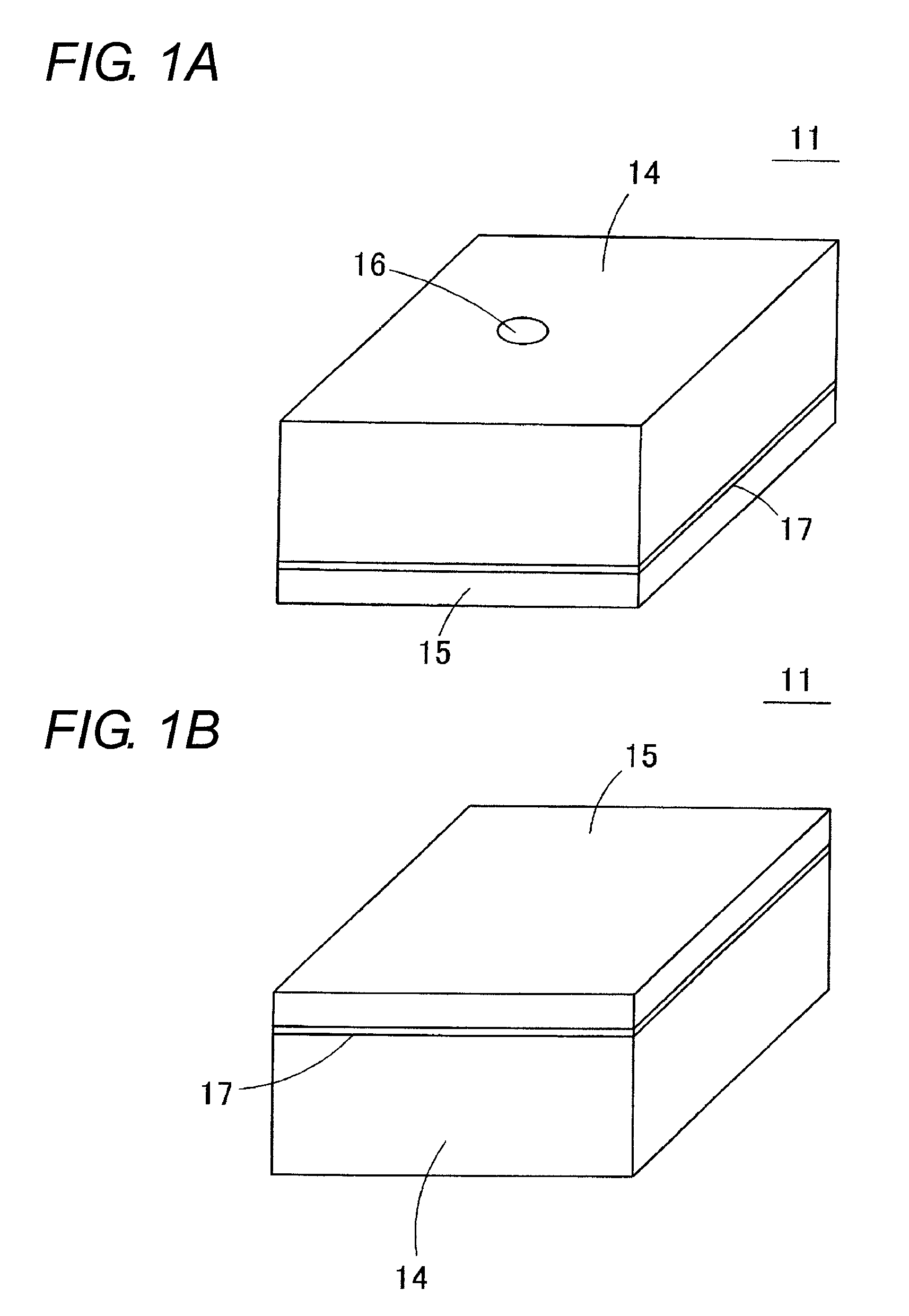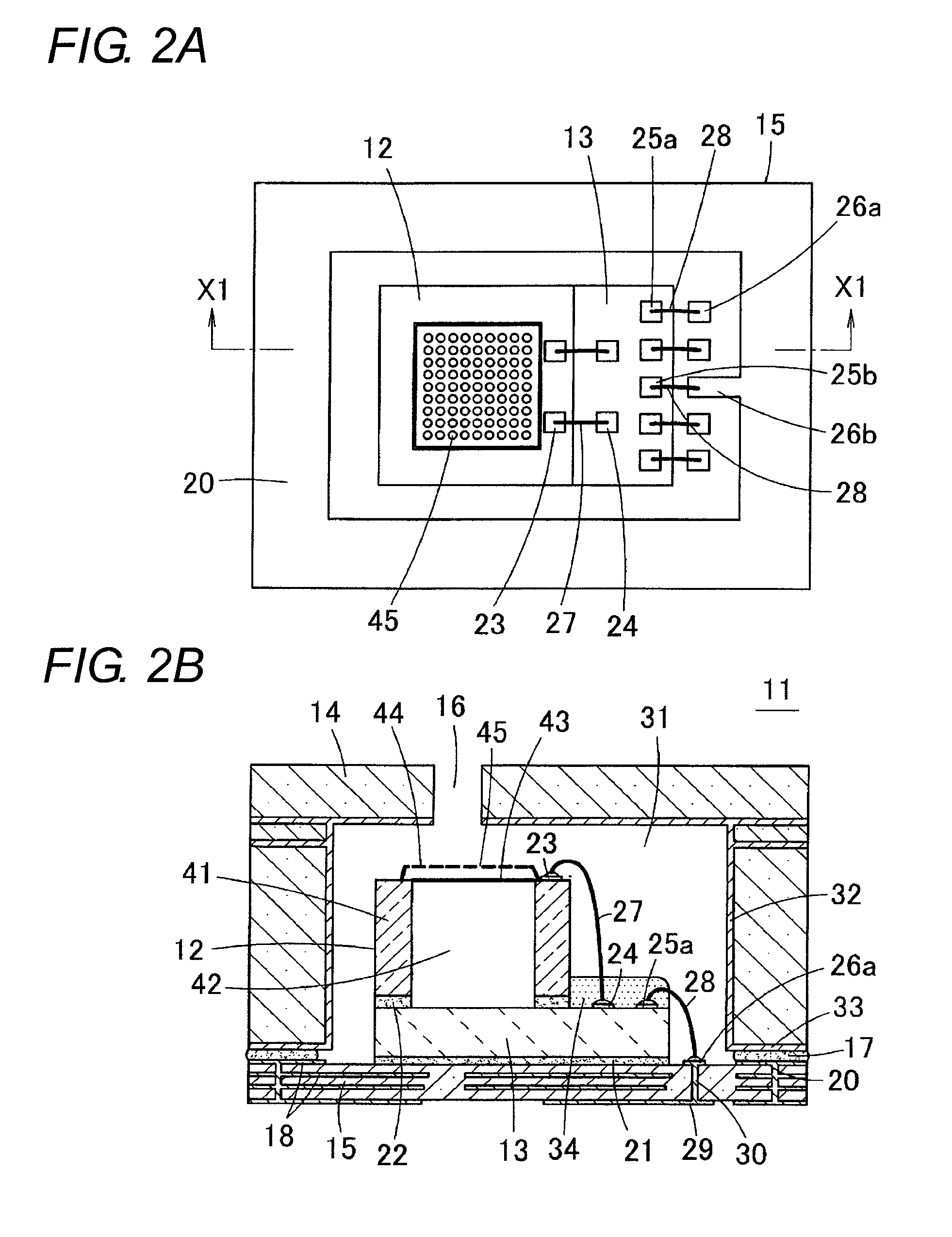Microphone
a microphone and microphone technology, applied in the field of microphones, can solve the problems of difficult to reduce the occupying area, difficult to miniaturize the microphone, and reduce the sensitivity, and achieve the effect of small mounting area
- Summary
- Abstract
- Description
- Claims
- Application Information
AI Technical Summary
Benefits of technology
Problems solved by technology
Method used
Image
Examples
first embodiment
[0050]An upper surface sound hole type microphone 11 according to a first embodiment of the present invention will be described with reference to FIGS. 1A and 1B, and FIGS. 2A and 2B. FIGS. 1A and 1B are a perspective view from an upper surface side and a perspective view from a lower surface side of the microphone 11 according to the first embodiment. FIG. 2A is a plan view of a substrate 15 on which a microphone chip 12 and a circuit element 13 are mounted, and FIG. 2B is a cross-sectional view of the microphone 11 taken along an area corresponding to line X1-X1 in FIG. 2A. Such a microphone 11 is a MEMS microphone manufactured using the MEMS technique, where the microphone chip 12 and the circuit element 13 are accommodated in a package made from a cover 14 (one of a cover or a substrate) and a substrate 15 (other one of the cover or the substrate). The structure of the microphone 11 will be specifically described below.
[0051]As shown in FIGS. 2A and 2B, the substrate 15 is forme...
second embodiment
[0062]FIGS. 3A and 3B are a perspective view from an upper surface side and a perspective view from a lower surface side of a microphone 51 according to a second embodiment of the present invention. FIG. 4A is a plan view of a substrate 15 on which a microphone chip 12 and a circuit element 13 are mounted, and FIG. 4B is a cross-sectional view of the microphone 51 taken along an area corresponding to line X2-X2 in FIG. 4A.
[0063]The microphone 51 of the second embodiment differs from the microphone 11 of the first embodiment in that the acoustic perforation 16 is arranged not in the cover 14 but at a position deviated from the circuit element 13 in the substrate 15. In particular, the acoustic perforation 16 is opened at a position adjacent to the circuit element 13 to miniaturize the microphone 51. The structure substantially similar to the microphone 11 of the first embodiment is adopted for other aspects, and thus the same reference numerals are denoted for the same configuring po...
third embodiment
[0064]A microphone 52 according to a third embodiment of the present invention will now be described. FIG. 5A is a bottom view of the cover 14 on which the microphone chip 12 and the circuit element 13 are mounted in the microphone 52 of the third embodiment, and FIG. 5B is a cross-sectional view of the microphone 52 taken along an area corresponding to line X3-X3 in FIG. 5A.
[0065]In the microphone 52 of the third embodiment, the circuit element 13 and the microphone chip 12 are installed on the lower surface of the cover 14 while being turned upside down. In other words, the circuit element 13 is installed on the top surface in the recess 31 of the cover 14 by the die attach material 21 while being turned upside down. The microphone chip 12 is fixed to the lower surface of the circuit element 13 by the die attach material 22 while being turned upside down. A plurality of pad portions 26c is arranged on the lower surface of the cover 14 while being electrically insulated with the co...
PUM
 Login to View More
Login to View More Abstract
Description
Claims
Application Information
 Login to View More
Login to View More - R&D
- Intellectual Property
- Life Sciences
- Materials
- Tech Scout
- Unparalleled Data Quality
- Higher Quality Content
- 60% Fewer Hallucinations
Browse by: Latest US Patents, China's latest patents, Technical Efficacy Thesaurus, Application Domain, Technology Topic, Popular Technical Reports.
© 2025 PatSnap. All rights reserved.Legal|Privacy policy|Modern Slavery Act Transparency Statement|Sitemap|About US| Contact US: help@patsnap.com



